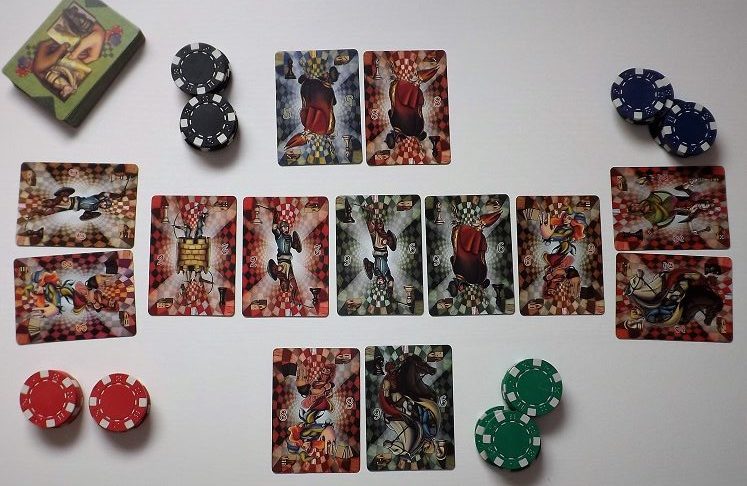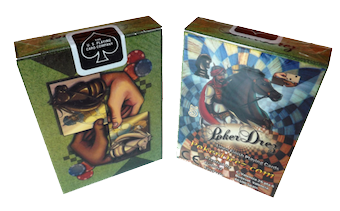Poker7
Poker7 is played similarly to the Texas Hold’em variant of regular poker, but with Pokerdrez cards.

Components
- A complete deck of 56 Pokerdrez cards will be used.
- The two neutral cards will not be involved in this game.
- At the start of the game, each player will receive an equal number of chips for betting.
- In each round, players will be dealt two cards that they will keep hidden from the others.
Betting
The betting rules are the same as those for Texas Hold’em Poker: Each time a player raises a bet, the others must match it to continue or surpass it, forcing the rest to cover.
Betting will occur:
- At the beginning where everyone contributes the minimum bet,
- After receiving the two hidden or pocket cards,
- After placing the first three community cards.
- After placing the final two community cards (both at once),
- After each player reveals one of their two hidden cards (this step sets Poker7 apart from traditional Poker and makes it more interesting).
Objective by rounds
Having the best combination (hand) among the 7 cards (5 common and 2 individual) among all players. (not just 5 of them as in regular Poker)
Hierarchy of combinations
Group Size
Between two hands, the winner will be the one with the larger group of cards of the same type (same figure or same color).
If there is a tie in quantity, the same criterion will be applied among the rest of the cards in the hand. Each card will be counted in a single group, regardless of whether it has the same color as one and the same figure as another.
Example: If there are two hands with a group of 4 identical cards, the other three will be reviewed. If one of them has another group of three cards of the same type, while the other only has a group of two, then the first one will win.
Ordered Groups (Straights)
Between two groups of the same size, if one of them (and not the other) has all its cards consecutive (following the numbering of the figure or color), it will be the winner (even if the hierarchy of the other is higher).
Hierarchy of Cards
If both hands have groups of equal size (and the order of one of them has not broken the tie), then the hierarchy of the cards within the larger group will determine the winner:
Ordered from highest to lowest relevance:
1. Color (cards of the same color)
2. Jokers
3. Queens
4. Rooks
5. Bishops
6. Knights
7. Pawns
Between two groups of colors of equal size, the one whose color represents a higher number will win, considering the following list:
9: Green
8: Orange
7: Cyan
6: Yellow
5: Blue
4: Purple
3: Magenta
2: Red
1: Gray
Between two groups of the same size and the same color, the one with the figure with higher relevance will prevail.
Between two tied groups in dimension and the same figure, the one with the card with a higher-numbered color will win.

Example
Let’s assume we have four players. (see the image below)
- The player at the top has a blue bishop and an orange bishop.
- The player on the left has a yellow pawn and a magenta joker.
- The player at the bottom has an orange joker and a green knight.
- The player on the right has a red queen and a red knight.
The community cards are:
- A red rook
- A red pawn
- A green pawn
- A green bishop
- A yellow joker
Combining the personal and community cards:
- The player at the top has a group of three bishops (two personal and one common) and a secondary group of two red cards (the common rook and pawn).
- The player on the left has a larger group of three pawns (one personal and two common) and a group of two jokers (one personal and one common). Although the number of groups is the same as the one at the top, the larger group is of pawns, which loses against bishops.
- The player at the bottom has a larger group of three green cards (one personal and two common) and a second group of two red cards (the other two community cards). This player wins against the one at the top because their larger group is of a color that beats any figure.
- The player on the right, on the other hand, is the only one with a group of four cards of the same color, in this case, red (two personal and two common).
In this way, the player on the right, with their larger group, is the winner of the hand and takes the entire pot.


